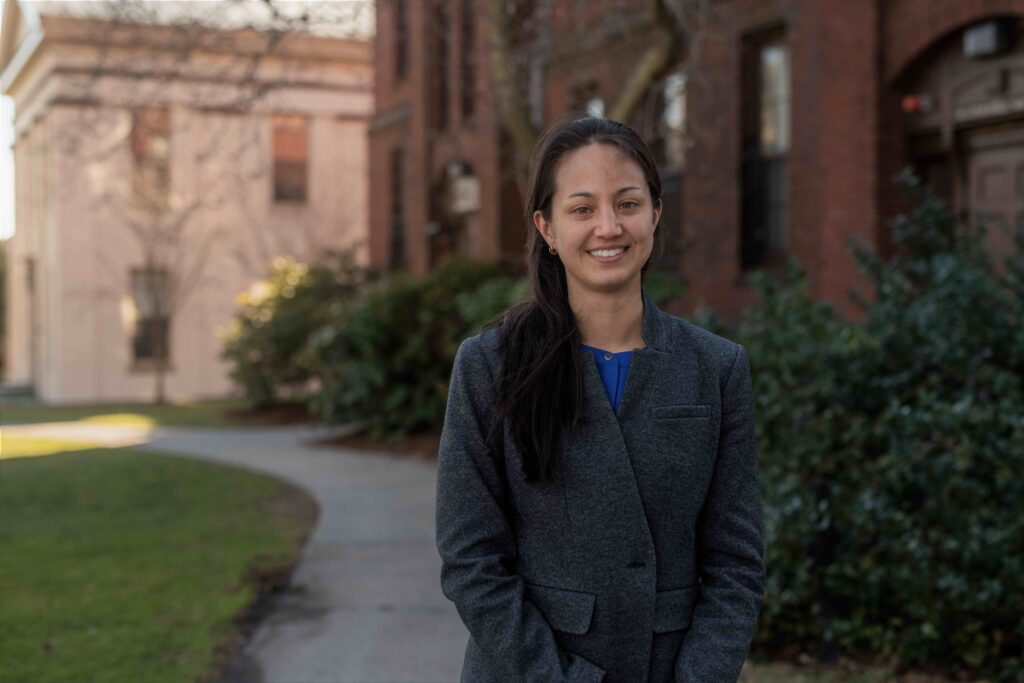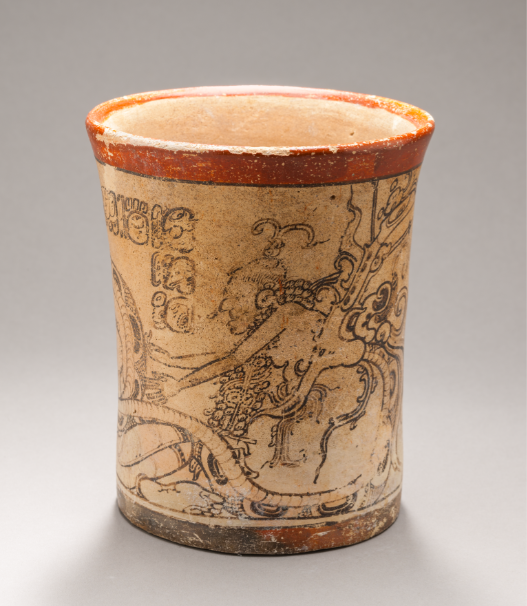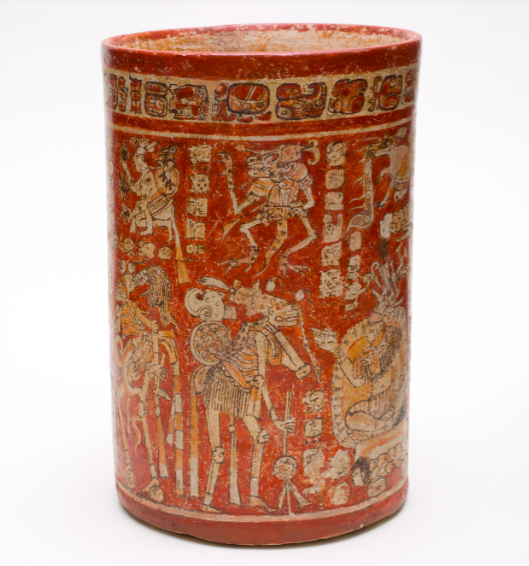
ONE OF THE MANY FASCINATING ASPECTS of Classic Maya civilization (250–900 CE) is that a series of common cultural traits appear in settlements that are widely distributed geographically, yet they do not appear to have originated in one central location. “They were shared among populations that were not only distant in space and time, but were never united as a single polity,” Assistant Professor Mallory Matsumoto (Department of Religious Studies) explained in a recent online presentation. “In this context of political fragmentation, we still remain pretty ignorant of how this culture developed and spread across the area.”
Matsumoto is an anthropologist whose work bridges archaeology, epigraphy, ethnohistory, and linguistic anthropology to examine language, religion, and material culture in pre-colonial and colonial Maya communities in Mexico and Central America. She earned a PhD in anthropology from Brown University in 2021.
In a talk titled “Circulating Religious Knowledge in Classic Maya Culture,” given in March 2022, Matsumoto brings together her research on Maya hieroglyphs, supernatural Classic Maya scribes, and a phenomenon (and symbol) known as wahy, meaning ‘sleep, transform’ or ‘companion spirit’. Below, Matsumoto discusses what brought her to the crossroads of diverse disciplines.

What first drew you to Maya studies?
The potential to combine my interests in archaeology and languages. I was also extremely fortunate to have several teachers along the way, from grade school through graduate school, who encouraged me to think of school and these subjects as contexts where I could thrive. I became interested in archaeology as a kid; growing up in Virginia, I visited a lot of historical sites on school field trips and with my family from a young age. I was also really interested in languages, and I was afraid I’d have to pick one or the other. But as an undergraduate, I learned more about what archaeology and linguistics are really about, as well as about epigraphy, the study of ancient inscriptions. Once I learned that Mesoamerican studies was a space where I could bring it all together, I couldn’t resist.
What is the connection between studying Classic-era hieroglyphs and delving into the realm of religion and belief systems? What was your path in that regard?
Since the beginnings of formal Mesoamerican studies in the nineteenth century, there’s been a strong focus among scholars on religion and the calendar—in part because that’s something that they were really attuned to at the time, in part because it offered an avenue into interpreting sources that no one could read phonetically at the time. That legacy remains. But another aspect of the almost omnipresence of religion in studies of pre-colonial Mesoamerica is the reality that what tends to get called “religion” really was seamlessly integrated into daily life in a way that nineteenth- and even twenty-first-century European and North American scholars aren’t familiar with from their own lives. So it makes sense that that integration is reflected in scholarship—and is pretty illustrative of my own path, too.

Diameter: 5 5/8 in. (14.29 cm) Height: 6 1/2 in. (16.51 cm). Los Angeles County Museum of Art.
How do Mayanists know the pronunciation of things written in the Classic period (and others)? For example, how do you know the pronunciation of wahy?
In short, thanks to several generations of very educated guesswork. What ultimately made Maya hieroglyphs decipherable (as opposed to, say, other older writing systems like Rongorongo on Easter Island) is that there are still several dozen Mayan languages spoken today in the same region where the Classic-period texts were found, so it was possible to connect those texts to known languages. None of these languages is identical to the one that was represented in the hieroglyphs, which researchers now refer to generically as “Classic Mayan,” but they’re all descended from a common, much more ancient ancestor language that linguists call “Proto-Mayan.” Based on detailed comparison of vocabulary and grammar from across all Mayan languages, including from available historical sources, historical linguists and epigraphers (people who study Maya hieroglyphs) have a pretty good idea of where Classic Mayan fits into the language family tree. Most agree that the closest “living” relative of Classic Mayan is a language called Ch’orti’, which is still spoken in eastern Guatemalan and western Honduras.
But, as one would expect for any writing system used for such a long period of time, there was variation, too. Some inscriptions from Yucatán Peninsula show clear influence from Yucatec, for instance, and others, from the area near what’s now the Chiapas–Guatemala border, preserve features that resemble modern-day Tzeltal, another Mayan language. Epigraphers are still working on a more detailed picture of linguistic variation in Classic Mayan inscriptions. At the same time, we still don’t know for sure how to pronounce some things. We don’t know how to read some hieroglyphs; most of the writing system has been deciphered by now, but not all of it. Even when we do have syllabic spellings of words, we don’t always know how a particular word was spoken out loud. In short, there’s still plenty more to be figured out.

What does your fieldwork look like?
As an archaeologist, my fieldwork is usually very hands on. I spent a month in early summer 2022 excavating at the site of Lacanja Tzeltal in Chiapas, Mexico, as part of a project directed by Andrew Scherer (Brown) and Charles Golden (Brandeis). But there have also been times when my “fieldwork” has more focused on visiting other archaeological sites or museums to examine artifacts there, or even going to archives to look at older photos of objects or sites that may look very different today or, in some cases, have since deteriorated or gone missing altogether. Similarly, as an ethno-historian, I’m not “in the field”; I’m usually in archives paging through manuscripts—or, especially during pandemic times, scrolling through scans or online finding aids—to track down information relevant to the topic at hand.
What courses will you be teaching in the coming academic year, and what can students expect to focus on with you?
In fall 2022, I’m teaching Introduction to the Study of Religion and an intro course on Classic Maya hieroglyphic writing (through Linguistics). In the spring, there will be a graduate seminar on language and religion in the colonial Spanish Americas, plus an undergraduate seminar on early Mesoamerican religions. ✹
About the UT Maya Cluster
THE UNIVERSITY OF TEXAS AT AUSTIN has welcomed four new faculty members who specialize in Maya studies. These newcomers, who started in fall 2021, are part of the Cluster and Interdisciplinary Hiring Initiative of the Office of the Executive Vice President and Provost. The initiative was developed to build on UT’s existing strengths, and to take them in new and exciting directions. Several UT faculty worked together to target new lines that would exist at the intersection of archaeology, environment, and religious studies, spanning the hard sciences and the humanities in exciting ways. The new hires that resulted reflect the future of interdisciplinary research in the Maya area, looking at concepts about the environment within Indigenous cosmology, resource exploitation and its changes over time, and human adaptations to changing environments. (The new hires are Thomas Garrison and Amy Thompson in Geography and the Environment, Iyaxel Cojti Ren in Anthropology, and Mallory Matsumoto in Religious Studies.) Each of these faculty is doing new and innovative research that overlaps with the others in interesting ways. As of now, UT can claim to have the largest community of scholars working in Maya studies anywhere in the world. It’s a boon for research and teaching, and it complements the exciting work UT Austin is already known for in Maya archaeology, art, and historical studies.
David Stuart
Schele Professor of Mesoamerican Art and Writing
Professor Matsumoto was interviewed by Portal editor Susanna Sharpe.
